Why Bleeding/Purging
Torches Matters
Nothing disrupts a cigar session like a torch lighter that sputters or won’t ignite, leaving your Robusto or Corona with an uneven burn. If your lighter’s flame is weak or inconsistent, air pockets in the fuel tank are often to blame. Knowing how to bleed a butane lighter is a must for cigar smokers to ensure a steady, reliable flame for perfect toasting. This simple maintenance trick removes trapped air, restoring your lighter’s performance, whether it’s a budget Vertigo or a premium S.T. Dupont. In this 2025 guide, we’ll walk you through a cigar-specific, step-by-step process to bleed your butane lighter, plus share Amazon products to keep it running smoothly. Ready to light your cigars flawlessly? Let’s dive into this essential fix for cigar enthusiasts.

Shop Torch Lighter Bleeding Tools At Amazon
Why Bleeding a Butane Lighter Matters for Cigars
Bleeding(or purging) a butane lighter removes air pockets trapped in the fuel tank during refilling, which can weaken or extinguish the flame. For cigar smokers, this maintenance step is critical for several reasons:
- Steady Flame: Air pockets disrupt fuel flow, causing sputtering that ruins the even burn needed for 42-60 ring gauge cigars.
- Reliable Ignition: Bleeding ensures instant lighting, avoiding delays during outdoor sessions (e.g., golf courses, patios).
- Lighter Longevity: Regular bleeding prevents strain on the burner jets, extending the life of lighters like Xikar or Jetline.
- Flavor Preservation: A consistent flame from a well-maintained lighter avoids scorching, preserving your cigar’s flavor.
Without bleeding, your lighter may fail mid-smoke, especially with larger cigars requiring longer toasting. This guide provides a cigar-focused process to bleed your lighter, plus tips to prevent future issues. Want the best fuel for refilling? Check our guide on the best butane fuel for torch lighters for top recommendations.
Best butane fuel for torch lighters
Step-by-Step Guide to Bleeding a Butane Lighter
Bleeding a butane lighter is a quick, easy process that takes 2-3 minutes and requires minimal tools. Follow these steps to restore your lighter’s flame for flawless cigar lighting.
Step 1: Gather Your Tools
Before bleeding, ensure you have the right tools to avoid damage to your lighter or injury.
- Tools Needed:
- Small flathead screwdriver or bleed tool (included in some lighter kits).
- High-purity butane (5x+ refined, e.g., Colibri Premium) for refilling after bleeding.
- Clean cloth to wipe the lighter.
- Cigar Tip: Keep a dedicated bleed tool handy for frequent cigar smoking to maintain lighters like Xikar or Vertigo.
- Safety Note: Work in a well-ventilated area, away from open flames or sparks.
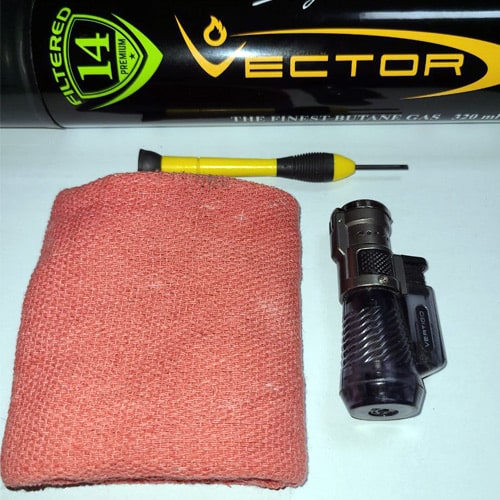
Step 2: Prepare the Lighter
Proper preparation ensures safe and effective bleeding without damaging your lighter.
- How to Prepare:
- Turn off the lighter and let it cool completely (5-10 minutes if recently used).
- Set the flame adjustment screw to the lowest setting (usually a “-” symbol, found on the bottom).
- Hold the lighter upright to locate the fill valve (a small metal or plastic nozzle).
- Cigar Tip: Lowering the flame setting prevents butane leaks, ensuring a clean bleed for lighters used with 42-50 ring gauge cigars.

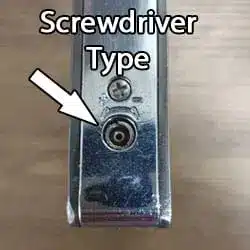
Step 3: Bleed the Air from the Fuel Tank
Bleeding removes trapped air, restoring fuel flow for a steady flame.
- How to Bleed:
- Hold the lighter upside-down (fill valve facing up).
- Gently press the fill valve with a screwdriver or bleed tool until you hear a hissing sound (escaping air and residual butane).
- Hold for 5-10 seconds or until the hissing stops, indicating the tank is empty.
- Wipe the valve with a cloth to remove any debris.
- Safety Note: Avoid sparks or flames during bleeding, as butane is flammable. Butane will come out of the valve fast. Please wear safety glasses!
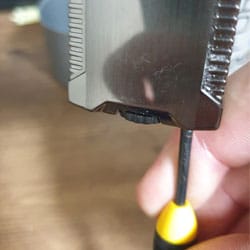
Shop Precision Screwdrivers on Amazon
See our guides on
Why won’t my torch lighter stay lit?
and
Why Does My Torch Lighter Sputter?
Step 4: Refill with High-Purity Butane
After bleeding, refilling with high-purity butane ensures a clean, consistent flame for cigars.
- How to Refill:
- Keep the lighter upside-down (fill valve up).
- Insert the butane can’s nozzle into the fill valve, ensuring a tight seal.
- Press the can in short bursts (3-5 seconds, 2-3 times) to fill the tank.
- Wait 1-2 minutes for the butane to settle before igniting.
- Cigar Tip: Use 5x+ refined butane (e.g., Vector KGM) to prevent clogs and preserve cigar flavor, especially for premium smokes.
- Product Needed: High-purity butane (e.g., Vector KGM, $15-$20).
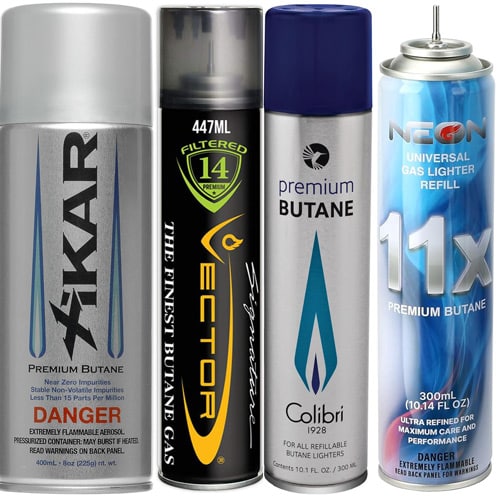
Shop High-Purity Butane on Amazon
Learn about the best butane fuel
for torch lighters here
Step 5: Test and Adjust the Flame
Testing ensures the lighter is fully functional, with adjustments for optimal cigar toasting.
- How to Test:
- Adjust the flame screw to a medium setting (usually halfway between “+” and “-”).
- Ignite the lighter and observe the flame (should be steady, blue, ~1-2 inches).
- If the flame is weak, bleed and refill again; if too high, lower the setting.
- Test on a non-valuable surface before lighting a cigar.
- Cigar Tip: A medium flame is ideal for 42-50 ring gauge cigars, ensuring even toasting without scorching.
- Product Needed: A reliable lighter if issues persist (e.g., Xikar Tactical 1, $40-$60).
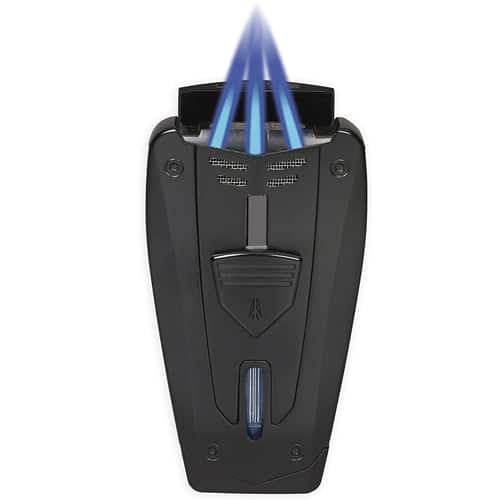
See our most reliable torch lighters for cigars
Tips to Prevent Future Lighter Issues
Bleeding your lighter is a key maintenance step, but these tips ensure long-term reliability for cigar smoking:
- Use High-Purity Butane: 5x+ refined butane (e.g., Colibri, Vector) prevents clogs. See our best butane fuel guide.
- Clean Jets Regularly: Use compressed air monthly to remove debris. Check our how to clean a torch lighter guide.
- Store Properly: Keep lighters in a cool, dry place to maintain valve integrity.
- Bleed Before Every Refill: Make bleeding a habit to avoid air pockets, especially for frequent cigar smokers.
These steps keep your lighter ready for every session, from 42-ring Coronas to 60-ring Churchills. Visit Amazon for butane and tools to maintain your lighter’s performance.
Learn why your torch lighter sputters
FAQs
How often should I bleed my butane lighter for cigars?
Bleed before every refill or monthly for regular cigar smokers to ensure a steady flame for 42-60 ring gauge cigars.
Why does my lighter sputter after bleeding?
Sputtering may indicate remaining air or clogged jets. Re-bleed and clean the jets (see our how to clean a torch lighter guide).
Can I use any butane after bleeding my lighter?
No, use 5x+ refined butane (e.g., Vector KGM) to prevent clogs. Explore our best butane fuel guide for recommendations.
What tools do I need to bleed a cigar lighter?
A small screwdriver or bleed tool and high-purity butane are sufficient. Shop tools on Amazon for convenience.
Should I replace my lighter if bleeding doesn’t work?
If issues persist, consider a reliable model like Xikar Tactical 1. See our most reliable torch lighters guide.
See the most reliable torch lighters
Conclusion To How to Bleed a Butane Lighter
Bleeding a butane lighter is a quick, essential fix to restore a steady flame for your cigar sessions. Our step-by-step guide ensures your lighter—whether a Vertigo or S.T. Dupont—ignites reliably for perfect toasting of 42-60 ring gauge cigars. Pair bleeding with high-purity butane and regular maintenance to keep your lighter in top shape. Shop our recommended butane, tools, and reliable lighters on Amazon to elevate your cigar experience, and share your maintenance tips in the comments below!
